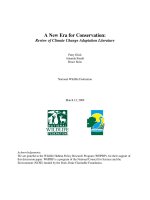A new record for Turkey: Solidago canadensis L.
Bạn đang xem bản rút gọn của tài liệu. Xem và tải ngay bản đầy đủ của tài liệu tại đây (112.13 KB, 3 trang )
Turk J Bot
27 (2003) 155-157
© TÜB‹TAK
Research Note
A New Record for Turkey: Solidago canadensis L.
Salih TERZ‹O⁄LU, Rahim ANfi‹N
Karadeniz Technical University, Faculty of Forestry, Department of Forest Botany, 61080 Trabzon - TURKEY
Emel KANO⁄LU
Bozkurt Forest Enterprise, 37660 Kastamonu - TURKEY
Received: 15..03.2002
Accepted: 24.10.2002
Abstract: Solidago canadensis L. (Compositae) is reported for the first time (A5 Kastamonu) for the flora of Turkey; it is a
naturalized alien.
Key Words: Solidago, new record, Turkey, Compositae
Türkiye ‹çin Yeni Bir Kay›t: Solidago canadensis L.
Özet: Solidago canadensis L. (Compositae) Türkiye’den (A5 Kastamonu) ilk defa kaydedilmifl olup, do¤allaflm›fl bir yabanc› türdür.
Anahtar Sözcükler: Solidago, Yeni Kay›t, Türkiye, Compositae
Solidago canadensis L., Sp.Pl. 878 (1753) (Fig. 1,
Introduction
Solidago canadensis was collected in Kastamonu (A5)
province during an expedition that was part of an MSc
study. It is not listed in the Flora of Turkey (Grierson,
1975), but is in Flora Europaea (McNeill, 1976), which
reported it as a naturalized species in Europe. Although
Solidago L. has more than 100 species (Burnie et al.,
1999), only one until now, the native S. virgaurea L., was
known from Turkey. S. canadensis is thus the second
Solidago species in Turkey.
Solidago consists of perennial herbs with rhizomes or
short rootstocks; the leaves are alternate, often toothed,
and the inflorescence is fasciculate, thyrsoid, or forming
scorpoid or sometimes corymbose panicles. Species of the
subgenus Solidago, to which S. canadensis belongs, all
originate from North America and have been grown
extensively in gardens; some have been reported as
naturalized. The subgenus Solidago has pedunculate
capitulas in which there are usually fewer ligules than
tubular florets. The filaments become free within the
corolla-tube, and receptacular pits are not fimbriate. This
last character distinguishes the subgenus Solidago from
Euthamia (McNeill, 1976).
2).
Perennial herb. Stems 30-150 cm, glabrous,
somewhat violet at base, pubescent or scabrid at least in
the upper part, with 40-100 leaves scarcely decreasing in
size upwards. Leaves lanceolate, long-attenuate,
pubescent or scabrid on the margin and veins beneath, or
occasionally throughout, sharply serrate, with two
prominent lateral veins distinct beneath; basal soon
deciduous; middle cauline leaves elliptic-lanceolate, 6-13 x
0.5-1.8 cm. Inflorescence a terminal panicle, capitula
secund; involucre 2-4 mm. Achenes 0.9-1.2 mm, shortly
pubescent; pappus 2-2.5 mm. Fl. 8-10. In stream beds
up to 100 m.
Type: ”Hab. Virginia, Canada”, Herb. Linn. 998.2
(LINN); Lectotype [A. Gray, 1882]). Kalm s.n., Herb.
Linn. 998.3 (LINN).
Native to North America and Canada. Cultivated for
ornament and widely naturalized in Europe (McNeill,
1976).
Examined specimens: A5 Kastamonu: Abana, along
the Harmuson stream, 10-100 m, 15.ix. 2000, KATO
13367, KTUB 315.
155
0.5 cm
A New Record for Turkey: Solidago canadensis L.
b
a
2 mm
4 cm
2 mm
c
d
Figure 1.
156
Solidago canadensis L.: a-habit, b-capitulum, c-ray flower, d-disc flower.
S. TERZ‹O⁄LU, R. ANfi‹N, E. KANO⁄LU
1
2
3
4
5
6
7
8
9
Figure 2.
10
42°
Distribution of Solidago
canadensis L. in Turkey (•).
A
40°
B
38°
C
0
26°
28°
30°
32°
34°
36°
38°
The cited specimens were stored in KATO (Herbarium
of Karadeniz Technical University, Faculty of Forestry,
Department of Forest Botany) and KTUB (Herbarium of
Karadeniz Technical University, Sciences and Arts Faculty,
Department of Biology).
Discussion
Two species of Solidago are now known from Turkey
and can be distinguished from each other as follows:
1. Inflorescence a thyrsoid or terminal panicle with
ascending branches; capitula not secund; involucre
4.5-8 mm; leaves with numerous divergent, often
indistinct lateral veins
S. virgaurea
1. Inflorescence a terminal panicle with patent
branches; capitula secund; involucre 2-4 mm;
leaves with two lateral veins running almost
parallel to the midrib for most of its length and
distinct beneath
S. canadensis
Diaspores of naturalized taxa which are adapted to
humid conditions can germinate easily in the Black Sea
100
40°
200
km
42°
36°
44°
region of Turkey. In common with Lepidium virginicum
L., Robinia pseudoacacia L., Acer negundo L., Aster
subulatus Michaux, Conyza canadensis (L.) Cronquist,
Erigeron annuus (L.) Pers., Tradescantia fluminensis
Vellozo and Sicyos angulatus L., Solidago canadensis is
now known to be naturalized in both Europe (McNeill,
1976) and Turkey. Like the other eight species shared as
aliens between Turkey and Europe, S. canadensis is
naturalized in the western Black Sea region of Turkey,
providing further evidence for the effects on introduced
plants of climatic similarity between the two regions
(Terzio¤lu & Anflin, 2001). Three other North American
Solidago species (S. sempervirens L., S. gigantea Aiton
and S. graminifolia (L.) Salisb.) were naturalized in
Europe (McNeill, 1976) and may become naturalized in
Turkey in the future, because they like a warm and wet
climate and are commonly grown.
Acknowledgement
We thank Dr R.I. Milne (St. Andrews, Scotland, UK)
for critically reading the manuscript.
References
Burnie G, Forrester S, Greig D et al. (1999). Botanica. Australia: Random
House Australia Pty Ltd.
McNeill J (1976). Solidago L. in Tutin TG & Heywood VH (eds.) Flora
Europaea 4: 110-111. Cambridge: Cambridge University Press.
Grierson AJC (1975). Solidago L. in: Davis PH (ed.) Flora of Turkey and
the East Aegean Islands 5: 116-118. Edinburgh: Edinburgh
University Press.
Terzio¤lu S & Anflin R (2001). A Chorological Study on the Taxa
Naturalized in the Eastern Black Sea Region. Turkish Journal of
Agric and Forestry 25: 305-309.
157









